A Linear Response Framework for Radiative-Convective Instability
Author(s)
Beucler, Tom G.; Cronin, Timothy Wallace; Emanuel, Kerry Andrew
DownloadPublished version (2.877Mb)
Publisher with Creative Commons License
Publisher with Creative Commons License
Creative Commons Attribution
Terms of use
Metadata
Show full item recordAbstract
Radiative-convective equilibrium is a simple paradigm for the tropical climate, in which radiative cooling balances convective heating in the absence of lateral energy transport. Recent studies have shown that a large-scale circulation may spontaneously develop from radiative-convective equilibrium through the interactions among water vapor, radiation, and convection. This potential instability, referred to as radiative-convective instability, may be posed as a linear stability problem for the water vapor profile by combining a linear response framework with the weak temperature gradient approximation. We design two analytic models of convective linear response to moisture perturbations, which are similar to Betts-Miller and bulk-plume convection schemes. We combine these convective responses with either clear-sky gray or real-gas radiative responses. In all cases, despite consistent radiative feedbacks, the characteristics of convection dominate the vertical structure of the most unstable linear mode of water vapor perturbations. For Betts-Miller convection, the stability critically depend on a key parameter: the heating to advection of moisture conversion rate (HAM); warmer atmospheres with higher HAM exhibit more linear instability. In contrast, bulk-plume convection is stable across temperatures but becomes linearly unstable with a moisture mode peaking in the midtroposphere once combined to radiation, with approximate growth rates of 10 days.
Date issued
2018-08Department
Massachusetts Institute of Technology. Department of Earth, Atmospheric, and Planetary SciencesJournal
Journal of Advances in Modelling Earth Systems
Publisher
American Geophysical Union (AGU)
Citation
Beucler, Tom, Timothy Cronin and Kerry Emanuel. “A Linear Response Framework for Radiative-Convective Instability.” 10 (2018): 1924-1951 © 2018 The Author(s)
Version: Final published version
ISSN
1942-2466